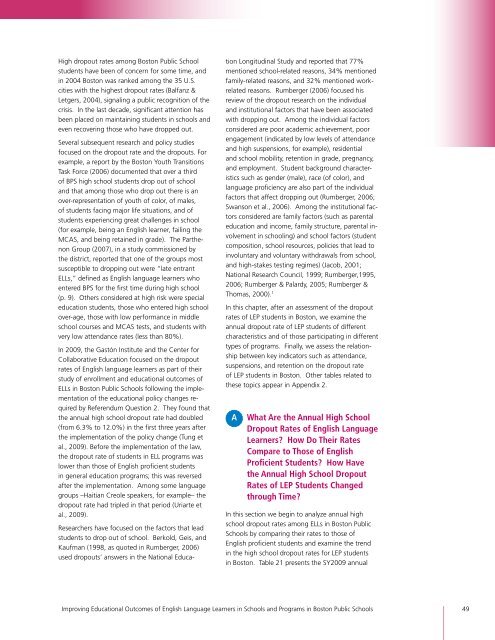Full Report - Center for Collaborative Education
Full Report - Center for Collaborative Education
Full Report - Center for Collaborative Education
You also want an ePaper? Increase the reach of your titles
YUMPU automatically turns print PDFs into web optimized ePapers that Google loves.
High dropout rates among Boston Public School<br />
students have been of concern <strong>for</strong> some time, and<br />
in 2004 Boston was ranked among the 35 U.S.<br />
cities with the highest dropout rates (Balfanz &<br />
Letgers, 2004), signaling a public recognition of the<br />
crisis. In the last decade, significant attention has<br />
been placed on maintaining students in schools and<br />
even recovering those who have dropped out.<br />
Several subsequent research and policy studies<br />
focused on the dropout rate and the dropouts. For<br />
example, a report by the Boston Youth Transitions<br />
Task Force (2006) documented that over a third<br />
of BPS high school students drop out of school<br />
and that among those who drop out there is an<br />
over-representation of youth of color, of males,<br />
of students facing major life situations, and of<br />
students experiencing great challenges in school<br />
(<strong>for</strong> example, being an English learner, failing the<br />
MCAS, and being retained in grade). The Parthenon<br />
Group (2007), in a study commissioned by<br />
the district, reported that one of the groups most<br />
susceptible to dropping out were “late‐entrant<br />
ELLs,” defined as English language learners who<br />
entered BPS <strong>for</strong> the first time during high school<br />
(p. 9). Others considered at high risk were special<br />
education students, those who entered high school<br />
over-age, those with low per<strong>for</strong>mance in middle<br />
school courses and MCAS tests, and students with<br />
very low attendance rates (less than 80%).<br />
In 2009, the Gastón Institute and the <strong>Center</strong> <strong>for</strong><br />
<strong>Collaborative</strong> <strong>Education</strong> focused on the dropout<br />
rates of English language learners as part of their<br />
study of enrollment and educational outcomes of<br />
ELLs in Boston Public Schools following the implementation<br />
of the educational policy changes required<br />
by Referendum Question 2. They found that<br />
the annual high school dropout rate had doubled<br />
(from 6.3% to 12.0%) in the first three years after<br />
the implementation of the policy change (Tung et<br />
al., 2009). Be<strong>for</strong>e the implementation of the law,<br />
the dropout rate of students in ELL programs was<br />
lower than those of English proficient students<br />
in general education programs; this was reversed<br />
after the implementation. Among some language<br />
groups –Haitian Creole speakers, <strong>for</strong> example– the<br />
dropout rate had tripled in that period (Uriarte et<br />
al., 2009).<br />
Researchers have focused on the factors that lead<br />
students to drop out of school. Berkold, Geis, and<br />
Kaufman (1998, as quoted in Rumberger, 2006)<br />
used dropouts’ answers in the National Educa-<br />
tion Longitudinal Study and reported that 77%<br />
mentioned school-related reasons, 34% mentioned<br />
family-related reasons, and 32% mentioned workrelated<br />
reasons. Rumberger (2006) focused his<br />
review of the dropout research on the individual<br />
and institutional factors that have been associated<br />
with dropping out. Among the individual factors<br />
considered are poor academic achievement, poor<br />
engagement (indicated by low levels of attendance<br />
and high suspensions, <strong>for</strong> example), residential<br />
and school mobility, retention in grade, pregnancy,<br />
and employment. Student background characteristics<br />
such as gender (male), race (of color), and<br />
language proficiency are also part of the individual<br />
factors that affect dropping out (Rumberger, 2006;<br />
Swanson et al., 2006). Among the institutional factors<br />
considered are family factors (such as parental<br />
education and income, family structure, parental involvement<br />
in schooling) and school factors (student<br />
composition, school resources, policies that lead to<br />
involuntary and voluntary withdrawals from school,<br />
and high-stakes testing regimes) (Jacob, 2001;<br />
National Research Council, 1999; Rumberger,1995,<br />
2006; Rumberger & Palardy, 2005; Rumberger &<br />
Thomas, 2000). 1<br />
In this chapter, after an assessment of the dropout<br />
rates of LEP students in Boston, we examine the<br />
annual dropout rate of LEP students of different<br />
characteristics and of those participating in different<br />
types of programs. Finally, we assess the relationship<br />
between key indicators such as attendance,<br />
suspensions, and retention on the dropout rate<br />
of LEP students in Boston. Other tables related to<br />
these topics appear in Appendix 2.<br />
A What Are the Annual High School<br />
Dropout Rates of English Language<br />
Learners? How Do Their Rates<br />
Compare to Those of English<br />
Proficient Students? How Have<br />
the Annual High School Dropout<br />
Rates of LEP Students Changed<br />
through Time?<br />
In this section we begin to analyze annual high<br />
school dropout rates among ELLs in Boston Public<br />
Schools by comparing their rates to those of<br />
English proficient students and examine the trend<br />
in the high school dropout rates <strong>for</strong> LEP students<br />
in Boston. Table 21 presents the SY2009 annual<br />
Improving <strong>Education</strong>al Outcomes of English Language Learners in Schools and Programs in Boston Public Schools 49


